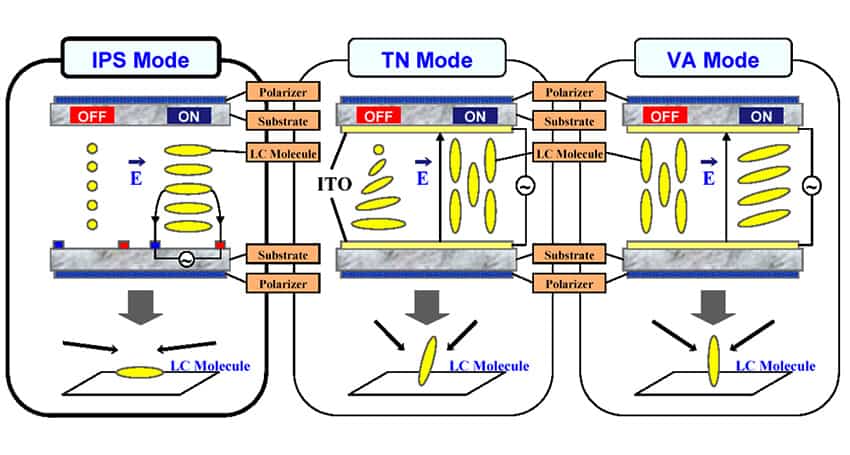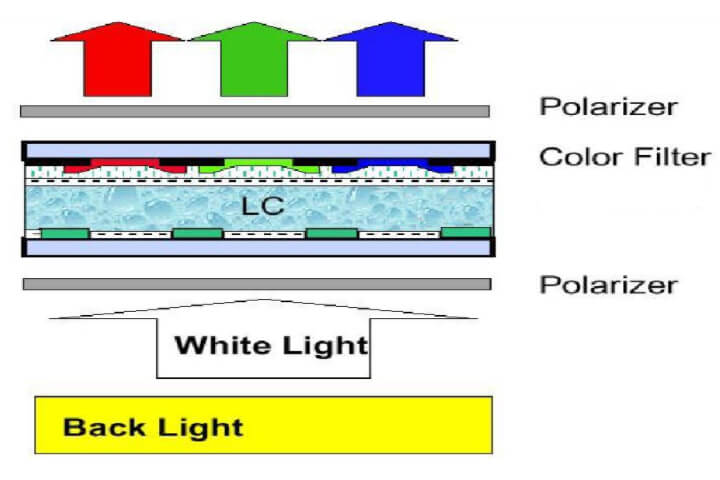Before introducing the LCD display screen, What's an LCD. LCD (liquid crystal display), is the flat and ultra-thin display device, get through the liquid crystal molecules are stimulated by current to generate dots, lines, and surfaces, and the backlights of the mirrors and the back lamps are combined to form a picture, however the liquid crystal itself does not emit light.
Note: Liquid crystal is a kind of special substance between solid and liquid. It is an organic compound, normally in the liquid state, but its molecular arrangement is very regular like that of solid crystal, so it is named liquid crystal. In addition, LCD is a general term.
Currently, LCD display screens are usually referred to as tft-lcd, mainly because TN-LCD, VA-LCD, and IPS-LCD all adopt TFT driver technology, which requires backlight support. TN, VA and IPS are liquid crystal display technologies, the difference is that liquid crystal molecules are arranged in different forms.

Molecular arrangement of TN(Twisted Nematic), IPS(In-Plane-Switching) and VA(Vertical Alignment) .
In terms of the arrangement of liquid crystal molecules in the dimension of panel materials, LCD screen mainly includes the following types:
TN Panels namely Twisted Nematic Panel. Due to its low production cost, TN has become the most widely used entry-level liquid crystal Panel and is widely used in the mainstream medium and low-end liquid crystal displays in the market. The disadvantages of TN panels are small visual Angle and limited color restoration ability. The advantage of TN panels is that the number of gray output is small, the liquid crystal molecule deflection speed is fast, the response time is easy to improve.
Taiwan a lot of panel manufacturers produce TN panel, TN panel belongs to soft screen, with the hand gently will appear similar water pattern.
VA Panels namely Vertical Alignment Panel. VA Panels are Panel that is widely used in high-end liquid crystal and belongs to the Panel of wide Angle. Compared with TN panel, the advantage of the 8bit VA panel is that it can provide 16.7m color, large visual Angle and better color restoration ability, but the disadvantage is also obvious that the price is more expensive than TN panel. There are two types of VA panels: the MVA panel led by Fujitsu and the PVA panel developed by Samsung, among which the latter is the inheritance and improvement of the former.
In addition, the front (Face) contrast of VA panels is the highest, but the uniformity of the screen is not good enough, and color drift often occurs. Sharp text is its killer, with high contrast between black and white.
The VA panel is also a soft screen. A similar water pattern will appear when you carefully look at the screen and gently stroke it.
IPS Panels namely Vertical Alignment Panel. It is the LCD panel technology launched by Hitachi company in 2001, commonly known as "Super TFT".
The advantages of IPS panel are large visual Angle, fast response, accurate color restore, cheap. However, the disadvantage is that the problem of light leakage is serious and black purity is not enough, which is slightly worse than PVA. Therefore, it needs to rely on the compensation of optical film to achieve a better black.
The biggest feature of the IPS panel is that its poles are all on the same surface, unlike the electrodes of other liquid crystal modes, which are arranged in a three-dimensional arrangement on the top and bottom. Since the electrodes are in the same plane, the liquid crystal molecules are always parallel to the screen in whatever state, which will reduce the opening rate and light transmittance, so IPS will need more backlight lamps in LCD TV.
In general, the advantages of the LCD screen are compared to CRT displays, while those for OLED self-illumination types have their own advantages.
LCD VS CRT, Take up much less space and be lighter.
LCD VS CRT, Energy saving, low power consumption.
LCD VS CRT, The lcd display is much brighter, with better resolution and contrast, and the output is sharper.
LCD VS CRT, The screen is visible with little flicker and the eyes are more comfortable.
LCD VS CRT, Extended service life of 1.3-1.5 million hours.
The LCD display is mainly composed of backlight module and LCD screen module.

Note: The above picture shows how the transmissive LCD Screen works. For the transflective modes etc., the same is true, except in slightly different ways.
Backlight module: provides light source
Top and bottom polarized plates, TFT Glass Substrate, liquid crystal: form polarized light and control the passage of light
Color filter: the source of TFT LCD R/G/B(three primary colors)
ITO transparent conductive layer: provides a transparent conductive path
Photo Spacer: provides a fixed height to color filters and TFT Glass Substrate, as a space to inject liquid crystals, and as a support for the upper and lower layers of Glass.
①. According to the motherboard, select the applicable screen. Elements: size, thickness, resolution;
②. Display characteristics and effect requirements.
Having said that, I believe readers should have a general understanding of the LCD screen.It is very common in life, used in many fields such as laptop computer screen, TVs, cell phones, tablets, and portable video games.